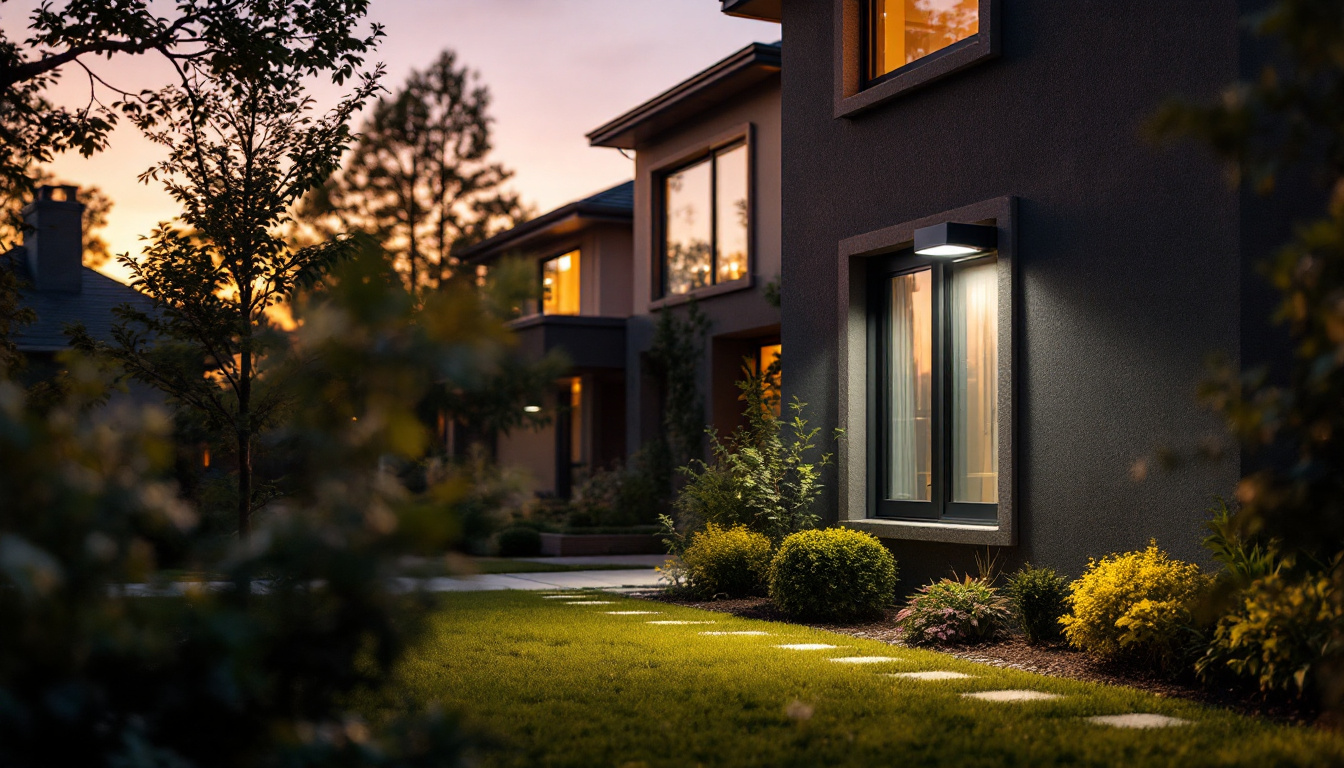
In the ever-evolving landscape of outdoor lighting, the integration of sensor technology has emerged as a game-changer for lighting contractors. These innovative solutions not only enhance security and convenience but also add a layer of sophistication to outdoor spaces. Understanding how outdoor lights with sensors impact projects is crucial for contractors aiming to stay ahead in a competitive market.
Outdoor lighting has traditionally focused on aesthetics and functionality. However, the growing demand for energy efficiency and smart home integration has propelled sensor technology to the forefront. Today, lighting contractors are increasingly incorporating these advanced systems into their designs, transforming how outdoor spaces are illuminated.
There are several types of sensors that can be integrated into outdoor lighting systems. Motion sensors are among the most popular, detecting movement and activating lights only when necessary. This not only conserves energy but also provides enhanced security for residential and commercial properties.
Another common type is the photocell sensor, which automatically adjusts lighting based on ambient light levels. This means that lights will turn on at dusk and off at dawn, ensuring that energy is used efficiently throughout the night. Additionally, smart sensors can be integrated with home automation systems, allowing for remote control and customization of lighting settings. These smart systems can even learn user habits over time, adapting to patterns such as when homeowners typically arrive home, thus optimizing energy use even further.
For lighting contractors, the benefits of incorporating sensor-equipped outdoor lights into projects are manifold. First and foremost, these systems significantly reduce energy consumption. By only activating lights when needed, clients can enjoy lower utility bills and a reduced carbon footprint.
Moreover, sensor lights enhance safety and security. Well-lit outdoor areas deter potential intruders and provide peace of mind for homeowners and business owners alike. This added security can be a significant selling point for contractors, making their services more appealing to clients. Additionally, the integration of advanced sensors can lead to a more immersive outdoor experience. For instance, path lights equipped with ambient sensors can create a warm, inviting atmosphere that adjusts to the number of people in the area, enhancing social gatherings or family events. This level of adaptability not only improves the functionality of outdoor spaces but also elevates the overall aesthetic, making them more enjoyable and usable at all hours of the day and night.
Integrating outdoor lights with sensors requires a shift in how lighting contractors approach design and planning. The inclusion of sensors can influence the layout, placement, and type of fixtures used in a project.
When designing outdoor lighting systems with sensors, contractors must consider the specific needs of the space. For instance, areas with high foot traffic may benefit from motion-activated lights that provide illumination only when movement is detected. Conversely, more static areas, such as gardens or pathways, may require photocell sensors to maintain consistent lighting throughout the night.
Additionally, the placement of sensors is crucial. Proper positioning ensures that the sensors can effectively detect movement or changes in light levels. This may involve strategic placement of fixtures and sensors to maximize their effectiveness while maintaining aesthetic appeal. For example, in a residential setting, lights can be integrated with landscaping features, such as trees or shrubs, to create a harmonious look while ensuring that the sensors are unobstructed and can function optimally.
Moreover, contractors should also take into account the technological advancements in sensor technology. Smart sensors can now connect to home automation systems, allowing homeowners to control their outdoor lighting remotely. This integration not only enhances convenience but also provides an additional layer of security, as homeowners can program lights to turn on and off at specific times or in response to certain triggers, such as the presence of an intruder.
While the benefits of sensor technology are clear, there are challenges that lighting contractors may face during implementation. One significant challenge is ensuring compatibility between different systems. Not all sensors work seamlessly with every type of lighting fixture, which can complicate the installation process.
Furthermore, outdoor environments present unique challenges, such as weather conditions and physical obstructions. Contractors must account for these factors when selecting and installing sensor-equipped lights, ensuring that they remain functional and reliable over time. For instance, sensors may need to be weatherproofed or shielded from direct exposure to rain and snow, which could otherwise impair their performance. Additionally, physical obstructions like fences or large trees can block the sensor’s line of sight, necessitating careful planning to ensure that the sensors can operate effectively without interference.
Another challenge is the potential for false triggers, which can lead to unnecessary energy consumption and wear on the lighting fixtures. Contractors must carefully calibrate the sensitivity of the sensors to strike a balance between responsiveness and reliability. This may involve testing different settings in varying conditions to find the optimal configuration that minimizes false activations while still providing adequate lighting when needed.
As outdoor lights with sensors become more prevalent, educating clients about their benefits and functionalities is essential. Effective communication can enhance client satisfaction and lead to more successful projects.
When discussing outdoor lights with sensors, it’s important for contractors to highlight the advantages clearly. Clients may be particularly interested in how these systems can save them money on energy bills while also improving security. Providing real-world examples or case studies can help illustrate these benefits effectively.
Additionally, contractors should explain how sensor technology works, addressing any misconceptions clients may have. For instance, some clients may worry about false alarms or lights turning on at inopportune times. By explaining the technology and its capabilities, contractors can alleviate these concerns and build trust with their clients. It’s also beneficial to discuss the various types of sensors available, such as motion detectors, ambient light sensors, and timers, which can be tailored to meet specific needs. This personalized approach not only showcases the versatility of the technology but also helps clients feel more involved in the decision-making process.
After installation, ongoing maintenance and support are vital for ensuring the longevity and effectiveness of sensor-equipped outdoor lights. Contractors should offer maintenance packages that include regular checks and updates to the system, ensuring that clients receive the best possible service.
Furthermore, providing clients with clear instructions on how to operate and troubleshoot their lighting systems can empower them to take control of their outdoor lighting. This not only enhances client satisfaction but also fosters a long-term relationship between the contractor and the client. To further support clients, contractors can create user-friendly guides or video tutorials that visually demonstrate the operation and maintenance of the systems. This proactive approach not only reinforces the contractor’s commitment to service but also helps clients feel confident in managing their own systems, ultimately leading to a more positive experience and increased referrals.
The landscape of outdoor lighting is continuously evolving, with several trends emerging that are likely to shape the future of the industry. For lighting contractors, staying informed about these trends is essential for maintaining a competitive edge.
As smart home technology continues to advance, outdoor lights with sensors are increasingly being integrated into broader home automation systems. This allows homeowners to control their outdoor lighting remotely, set schedules, and customize lighting settings based on their preferences.
For contractors, understanding how to integrate these systems can open up new opportunities for projects. Offering smart home integration as part of outdoor lighting installations can attract tech-savvy clients looking for modern solutions. Additionally, the use of mobile apps to manage lighting can enhance user experience, allowing homeowners to adjust brightness, color, and even lighting patterns from their smartphones. This level of control not only adds convenience but also enables homeowners to create dynamic outdoor environments tailored for different occasions, whether it’s a cozy family gathering or a lively party.
With a growing emphasis on sustainability, the demand for energy-efficient outdoor lighting solutions is on the rise. Lighting contractors are encouraged to explore options such as LED fixtures and solar-powered lights, which align with eco-friendly practices.
Incorporating sensor technology into these energy-efficient solutions can further enhance their appeal. Clients are increasingly looking for ways to reduce their environmental impact, and offering sustainable options can set contractors apart from the competition. Moreover, the use of smart sensors can optimize energy consumption by ensuring that lights are only activated when needed, significantly lowering electricity bills. As more homeowners become aware of their carbon footprint, providing education on the long-term savings and environmental benefits of these technologies can help contractors build trust and rapport with clients, positioning themselves as knowledgeable advocates for sustainable living.
The integration of outdoor lights with sensors is transforming the landscape for lighting contractors. By understanding the benefits, challenges, and trends associated with these systems, contractors can enhance their project offerings and better serve their clients. As the demand for smart, energy-efficient solutions continues to grow, those who adapt and innovate will thrive in this dynamic industry.
Incorporating sensor technology into outdoor lighting projects not only improves functionality and aesthetics but also positions contractors as forward-thinking professionals in a competitive market. By embracing these advancements, lighting contractors can ensure their projects meet the evolving needs of clients while contributing to a more sustainable future.
Ready to elevate your lighting projects with the latest sensor-equipped outdoor lights? At LumenWholesale, we provide lighting contractors like you with the highest quality, spec-grade lighting products at prices that can’t be beaten. Our commitment to cutting out the middleman means you get the superior lighting you need for your innovative projects, without the inflated markups. With our extensive selection that meets rigorous industry standards, you can confidently integrate smart, energy-efficient solutions into your designs. Plus, with the convenience of free shipping on bulk orders, you can enjoy premium lighting at the best value — all with no hidden fees. Don’t compromise on quality or cost. Visit LumenWholesale today and discover the perfect blend of quality, affordability, and convenience for your next project.

Discover why barn style lights are becoming a staple for lighting contractors.

Discover how utilizing outside light can revolutionize your lighting projects by boosting efficiency and sustainability.

Discover essential insights for lighting contractors working on island projects.

Explore the pivotal role of chandeliers in church lighting installations, uncovering their historical significance, aesthetic impact, and functional benefits in enhancing worship spaces..